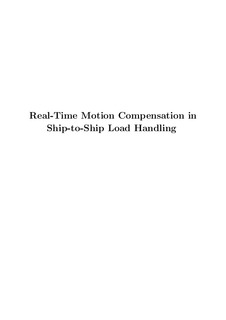| dc.contributor.author | Tørdal, Sondre Sanden | |
| dc.date.accessioned | 2019-03-15T08:52:20Z | |
| dc.date.available | 2019-03-15T08:52:20Z | |
| dc.date.issued | 2019 | |
| dc.identifier.isbn | 978-82-7117-919-9 | |
| dc.identifier.issn | 1504-9272 | |
| dc.identifier.uri | http://hdl.handle.net/11250/2590151 | |
| dc.description | Doktorgradsavhandling | nb_NO |
| dc.description.abstract | Like the automotive industry, the maritime industry is facing a higher demand for autonomous offshore operations. It is therefore in the author’s belief that the marine industry has to develop and implement new technology for both existing and new products to meet the increased autonomy demand. This thesis aims at presenting a unified understanding of the motions and the accompanying load handling issue in ship-to-ship operations. The ship-to-ship kinematics is modeled and a crane operator assistant is developed as a possible solution to increase the so-called weather window of ship-to-ship load transfers. The weather window is today determined by the significant wave height, and the current limitation of such operations is at 2.5m significant wave height. Proposing new methods capable of assisting the crane operator when transferring the load from one ship onto another is believed to further relax the weather window criteria, as well as increasing both the safety and efficiency of the operation itself. A novel ship-to-ship estimation algorithm using the well known Extended Kalman Filter (EKF) is developed and experimentally investigated in the Norwegian Motion Laboratory. In addition to the ship-to-ship observer, an observer for measuring the suspended load motions is developed. These estimators are used to form the novel crane operator assistant presented at the end of this thesis. The presented assistant consists of a wire-length assistant and an anti-swing assistant, which both aim at assisting the crane operator in ship-to-ship load transfers by adjusting the crane operator inputs slightly in real-time. The expected outcome is increased repeatability and efficiency, as well as reduced risk in general. The developed methods are described using a common and consistent mathematical notation for both the observers and the kinematic control systems. The appended papers at the end of this thesis have experimentally investigated and validated the proposed methods using several experiments which have been carried out in the Norwegian Motion Laboratory | nb_NO |
| dc.language.iso | eng | nb_NO |
| dc.publisher | Universitet i Agder / University of Agder | nb_NO |
| dc.relation.ispartofseries | Doctoral dissertations at University of Agder; | |
| dc.relation.ispartofseries | ;220 | |
| dc.title | Real-Time Motion Compensation in Ship-to-Ship Load Handling | nb_NO |
| dc.type | Doctoral thesis | nb_NO |
| dc.subject.nsi | VDP::Social science: 200::Economics: 210::Business: 213 | nb_NO |
| dc.subject.nsi | VDP::Technology: 500::Information and communication technology: 550 | nb_NO |
| dc.source.pagenumber | 71 | nb_NO |
